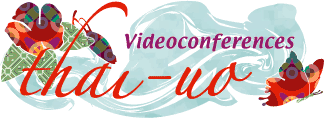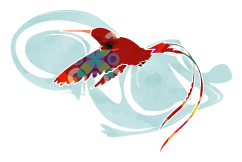Archived Series – Critical Thinking 1
 |
||
 |
Documents |
2004-05 Archived Handouts and Resources Handout: Critical Thinking Key TermsSee readings in Online Resources on this page. |
Videos |
2004-05 ArchivedLecture PresentationOnline access to the videoconference lecture requires a broadband (DSL, cable, ethernet, etc.) Internet connection. The lecture is available in RealPlayer formats for both Windows and Macintosh computers: Video Session, RealPlayer Format |
2004-05 Archived Series – January 21, 2005
Critical Thinking Across the Language Curriculum, Part I
Cynthia Kieffer and Leslie Opp-Beckman, Speakers
January 21, 2005
Overview
This is the third lecture in a 10-part professional development series for English as a Foreign Language educators in Thailand. University of Oregon is partnering with the US Embassy in Bangkok, the Royal Thai Distance Learning Foundation, colleagues at Chulalongkorn University, and at ThaiTESOL on this innovative and exciting project.
This is the first of two parts on Critical Thinking Skills.The focus for this first session is on some of the theoretical or pedagogical aspects of integrating Critical Thinking into the language learning curriculum. The practical side of integrating Critical Thinking in the language curriculum is continued as Part II in the fourth session on February 18, 2005.
About the Speakers
Cynthia Kieffer is a Senior Instructor at the UO’s American English Institute. For an overview of a class she has taught on this subject, visit her Critical Thinking Skills site.
Leslie Opp-Beckman is on faculty at the University of Oregon in the Linguistics Department and the American English Institute. She develops e-learning curriculum and and teaches courses on Computer-Assisted Language Learning.
Discussion Questions
- At what age can teachers expect students to begin developing CT skills?
- How do you assess students’ CT performance in the classroom?
- Are there any disadvantages to working with CT in an EFL classroom?
- What kind of administrative support do I need to make CT a success in my school?
Online Resources
Overview
This session combined critical thinking skills with a theme or content area that is often found in language teaching curriculum: biographies or profiles of famous people. For websites that offer good biographical search tools, see the following.
- Bartleby (see Biography section)
- Encyclopedia Britannica Online
- How Stuff Works, People Channel
Readings
The following readings are key to the lectures and activities on Critical Thinking for both Parts I (January 2005) and II (February 2005). They are listed in order of importance. If you have time to read only one, please start with the first one.
- Teaching Thinking Skills, Kathleen Cotton
This research paper addresses the importance of teaching students to think critically and creatively, and provides an overview of critical thinking definitions. Included is a summary of research findings in areas such as the teaching of critical thinking skills and academic achievement, and the controversies in thinking skills instruction. Notice the rich bibliography for additional readings. - Bloom’s Taxonomy
Benjamin Bloom created this taxonomy for categorizing level of abstraction of questions that commonly occur in educational settings. The taxonomy provides a useful structure in which to categorize test questions. If you can determine the levels of questions that appear on your exams (look at the question cues), you will be able to identify if you are asking students to think critically. - Learning Domains or Bloom’s Taxonomy
These charts summarize the three types of learning or domains of educational activities: cognitive, affective, and psychomotor. • Taxonomy of Socratic Questioning
http://www-ed.fnal.gov/trc/tutorial/taxonomy.html
The following table has been adapted from: Paul, Richard, Critical Thinking: How to Prepare Students for a Rapidly Changing World, 1993. It is an example of Socratic questioning to probe students for reasons and evidence. - The Critical Thinking Community
The Center For Critical Thinking has broken the global concept of critical thinking down into 35 aspects or instructional strategies. For a 2-page summary, see: Strategy List: 35 Dimensions of Critical Thought [MS Word document].
Post-lecture Classroom Applications
Continue with the readings from Online Resources above to prepare for Part II on Critical Thinking Skills in the February videoconference.